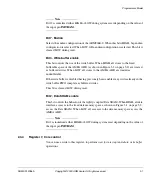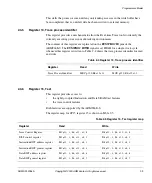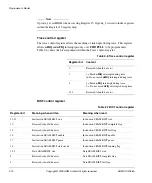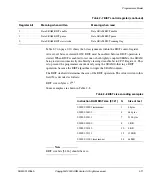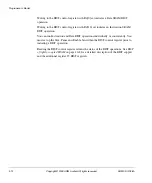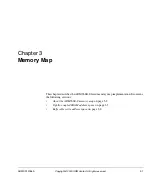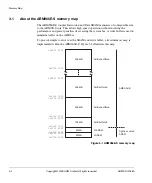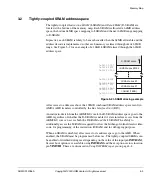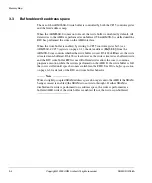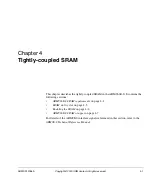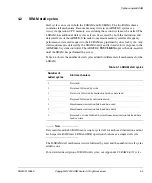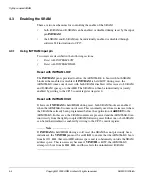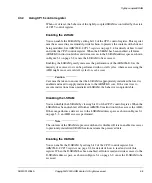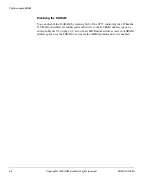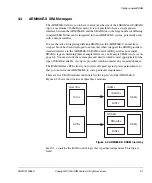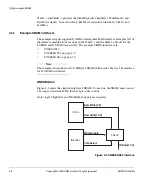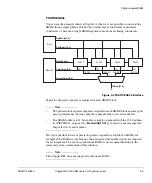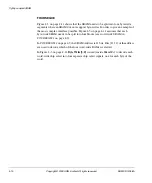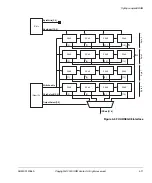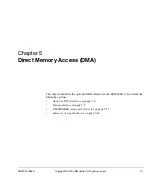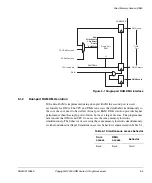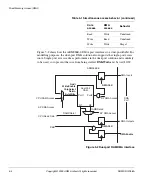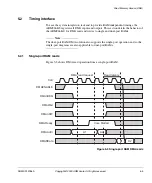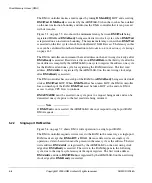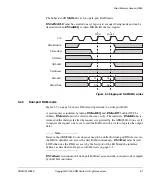
Tightly-coupled SRAM
ARM DDI 0186A
Copyright © 2000 ARM Limited. All rights reserved.
4-5
4.3.2
Using CP15 control register
When out of reset, the behavior of the tightly-coupled SRAM is controlled by the state
of CP15 control register.
Enabling the I-SRAM
You can enable the I-SRAM by setting bit 12 of the CP15 control register. This register
must be accessed in a read-modify-write fashion, to preserve the contents of the bits not
being modified. See
on page 2-4 for details of how to read
and write the CP15 control register. When the I-SRAM has been enabled, all future
ARM9E-S instruction fetches and data accesses to the I-SRAM address space as shown
in Figure 3-1 on page 3-2 causes the I-SRAM to be accessed.
Enabling the I-SRAM greatly increases the performance of the ARM966E-S as the
majority of accesses to it can be performed with no stall cycles, whereas accessing the
AHB might cause several stall cycles for
each
access.
Caution
Care must be taken to ensure that the I-SRAM is appropriately initialized before it is
enabled and used to supply instructions to the ARM9E-S core. If the core tries to
execute instructions from uninitialized I-SRAM, the behavior is unpredictable.
Disabling the I-SRAM
You can disable the I-SRAM by clearing bit 12 of the CP15 control register. When the
I-SRAM has been disabled, all further ARM9E-S instruction fetches access the AHB.
If the core performs a data access to the I-SRAM address space as shown in Figure 3-1
on page 3-2, an AHB access is performed.
Note
The contents of the SRAM are preserved when it is disabled. If it is re-enabled, accesses
to previously initialized SRAM locations returns the preserved data.
Enabling the D-SRAM
You can enable the D-SRAM by setting bit 2 of the CP15 control register. See
on page 2-4 for details of how to read and write this
register. When the D-SRAM has been enabled, all future read and write accesses to the
D-SRAM address space, as shown in Figure 3-1 on page 3-2, cause the D-SRAM to be
accessed.
Summary of Contents for ARM966E-S
Page 6: ...Contents vi Copyright 2000 ARM Limited All rights reserved ARM DDI 0186A ...
Page 20: ...Introduction 1 4 Copyright 2000 ARM Limited All rights reserved ARM DDI 0186A ...
Page 48: ...Tightly coupled SRAM 4 12 Copyright 2000 ARM Limited All rights reserved ARM DDI 0186A ...
Page 80: ...Bus Interface Unit 6 20 Copyright 2000 ARM Limited All rights reserved ARM DDI 0186A ...
Page 118: ...Debug Support 8 26 Copyright 2000 ARM Limited All rights reserved ARM DDI 0186A ...
Page 130: ...Test Support 10 8 Copyright 2000 ARM Limited All rights reserved ARM DDI 0186A ...
Page 142: ...Instruction cycle timings 11 12 Copyright 2000 ARM Limited All rights reserved ARM DDI 0186A ...
Page 158: ...Signal Descriptions A 16 Copyright 2000 ARM Limited All rights reserved ARM DDI 0186A ...
Page 176: ...AC Parameters B 18 Copyright 2000 ARM Limited All rights reserved ARM DDI 0186A ...

